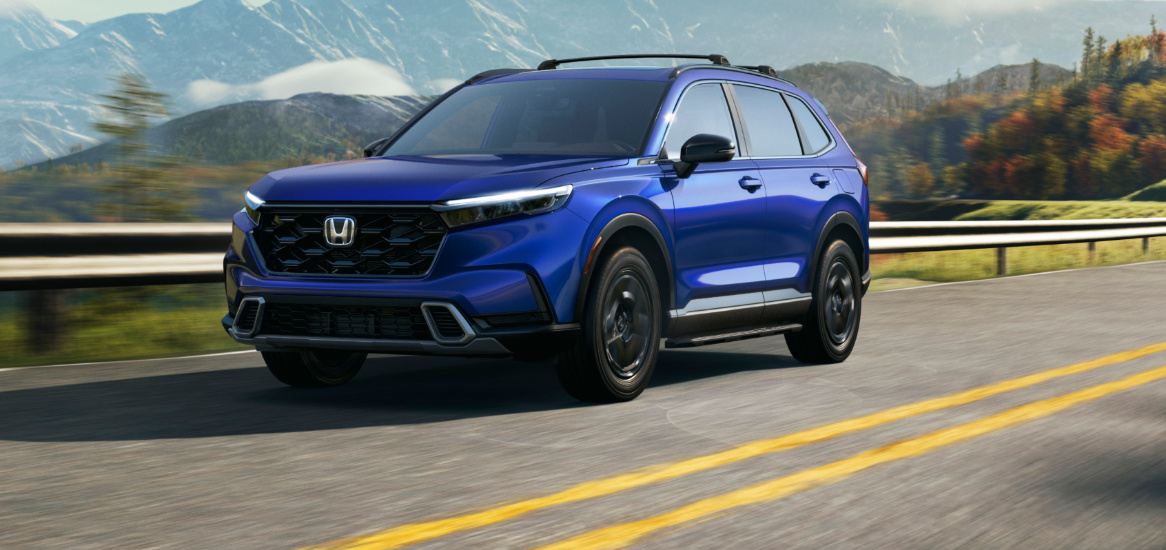The Chevy Trax and the Dodge Hornet represent the two newest compact crossovers on the market, yet they span the spectrum of affordability. The second iteration of the Chevy Trax has grown much larger and much more attractive, and all versions cost less than $25,000. The Dodge Hornet reorients the post-muscle car brand with premium ambitions and a sticker price between $32,000 and $45,000.
The design of each stands out more than what moves them, with the Trax taking on an almost wagon-like profile and a pedestrian but capable 137-hp turbo-3. In channeling the curvier Italian shape of an Alfa Romeo, the Dodge Hornet puts a sting in the brand’s performance id, offering a 268-hp turbo-4 in GT models and an R/T grade with a 288-hp plug-in hybrid powertrain and a 0-60 mph time of 5.6 seconds.
Price and performance are not all that separate these two volume crossovers. Here’s how they measure up in size, comfort, tech, safety, and style.
Dodge Hornet (blue) vs. Chevy Trax (black)
Chevy Trax vs. Dodge Hornet price and trims
- Trax costs between $21,495 and $24,995
- Hornet GT costs between $31,590 and $36,590
- Hornet R/T costs between $41,590 and $46,590
- Best picks: Trax LT, Hornet GT
Which Chevrolet Trax should I buy?
Chevy sells the Trax in LS, 1RS, LT, 2RS and Activ trims, and they’re all so reasonably priced, they’re a deal. For $21,495, the Trax LS comes with an 8.0-inch touchscreen with wireless Android Auto and Apple CarPlay, LED headlights, cloth upholstery, cruise control, and 17-inch wheels.
The $23,395 Trax LT upgrades to automatic climate control, rear-seat USB ports, and an 11.0-inch touchscreen. The $24,995 Trax 2RS has the same price as the Activ but has 19-inch black wheels and black trim elements whereas the Activ has 18-inch wheels and monochrome body coloring. They both have heated front seats and a heated steering wheel, and the 2RS has a flat-bottomed wheel. It’s the best looking of the bunch and our recommended pick. The Activ has a power driver seat. Either one can be optioned with a power sunroof, adaptive cruise control, and wireless smartphone charging to push its price just beyond $28,000.
Which Dodge Hornet should I buy?
It really comes down to which powertrain you want. Including a $1,595 destination fee, the GT costs $32,330 and the R/T costs $42,530. That’s a steep jump for the plug-in hybrid and its performance upgrades, but Dodge equips them both with a 12.3-inch digital instrument cluster, a 10.3-inch touchscreen operating the brand’s latest infotainment system, wireless Android Auto/Apple CarPlay/Amazon Alexa connectivity, and wireless smartphone charging. It’s one of the better operating systems on the market, and can host two phone profiles simultaneously so one can be used for navigation or calls and the other for multimedia. But the digital icons can be relatively small, and the screen crowded with info.
The GT is enough Hornet for us. The R/T adds power front seats that are heated, a heated steering wheel, and it rolls on 18-inch wheels instead of the GT’s 17-inch wheels.
The $5,000 Plus package available on both models adds a power sunroof, a Harman Kardon 14-speaker audio system, a hands-free power tailgate, leather upholstery, and cooled front seats.
Advantage: The Trax is a great value, but lacks premium options.

Dodge Hornet vs. Chevy Trax interior and exterior design
- The Trax rides low like a wagon
- The Hornet blends Italian curves with muscle car flair
- Trax interior transcends its price class
Is the Chevrolet Trax a good-looking car?
With its short overhangs, long wheelbase, and flat roofline, the new Trax looks as much like the larger Chevy Blazer as it does a high-riding wagon. It’s athletic instead of awkward like other small crossovers pretending to have off-road capability, which is a refreshing change. It sports a banded mesh grille tied with a Chevy bow, hawklike LED lights, and a swoopy tail that lifts up its shoulders at the rear end.
The good looks carry over inside with a low dash and a pair of screens angled toward the driver. It fits within the dash instead of overwhelming it. The blend of climate dials and controls below the digital interface strikes the right balance, and circular vents rimmed in colors exclusive to each trim bookend the dash. There’s plenty of plastic, and the volume control on the driver’s side sits too far away for passengers to have any control, but these are minor quibbles for a car that looks and feels richer than its price.

Dodge Hornet (blue) vs. Chevy Trax (black)
Is the Dodge Hornet a good-looking car?
Built in Italy alongside the Alfa Romeo Tonale, the Hornet gets injected with some muscle car flair compared to the curvy shape of its Italian cousin. The sculpted hood flexes two air vents before dipping down into the two-part grille, similar to the larger Dodge Durango three-row SUV. The Hornet’s thin headlights wrap around the fenders like old-school Oakley sunglasses, crowned by thin daytime running lights. Below them, air intakes frame the wide lower grille. One interesting design note is the cut of the rear doors, which have an ear-shaped lobe at the top corner that can be used as a secondary handle. At the rear, the full-width light signature affirms the Dodge pedigree, though you won’t find the brand name anywhere. Racing stripes are available, as are 20-inch alloy wheels and Brembo brake calipers.
The interior sports a flat-bottom steering wheel, a mechanical shifter in the console, and a chunky dash flanked by oblong vents. In the middle, twin screens enable a deep dive into gauges and performance data, but climate functions and the main drive modes are left to buttons and dials. It’s mostly a black affair with red cross-stitching, but an available Track Pack with Alcantara inserts boosts the interior with a more luxurious feel the Trax can’t approximate.
Advantage: The Hornet is bolder, but beauty lies with the beholder.

Dodge Hornet (blue) vs. Chevy Trax (black)
Dodge Hornet vs. Chevy Trax size, comfort, and cargo capacity
- They’re the same length and width, but the Hornet sits higher
- The Trax has more room for passengers
- Both seat five, but only four passengers in comfort
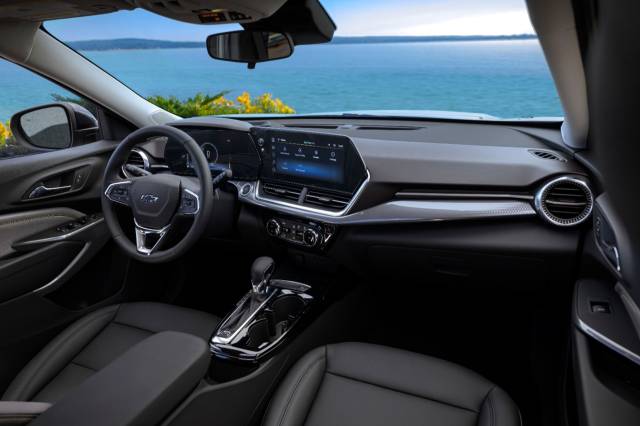
2024 Chevrolet Trax
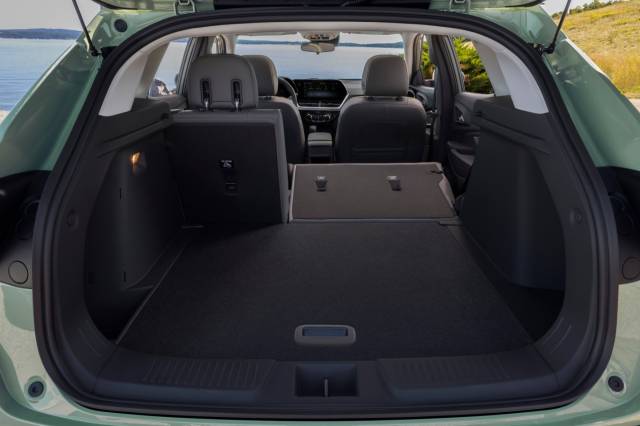
2024 Chevrolet Trax
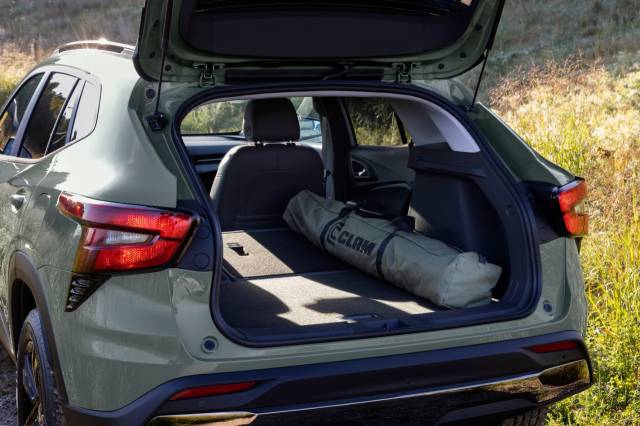
2024 Chevrolet Trax
How big is the Chevrolet Trax?
It’s bigger than its predecessor, now slotting between the larger Equinox and smaller Trailblazer in Chevy’s booming SUV family. It’s also roomier than the Dodge Hornet. At 178.6 inches, it’s only 0.6 inch longer than the Hornet, but the Trax’s longer wheelbase of 106.3 inches (vs. 103.8 in the Hornet) results in a roomier cabin. It easily fits four adults and their gear behind them, with 38.7 inches of rear legroom allowing plenty of stretch-out space.
The other notable dimensional difference between the two is in their heights. The 7.3 inches of ground clearance in the Trax leads to a shorter height of 61.4 inches. (The Hornet measures 8.0 inches of ground clearance and a height of 63.8 inches.) It makes the Trax seem as much like a wagon as a crossover, but wide door openings and a low step-in height make it easy to get in and out, and the flat roofline doesn’t crimp headroom. It could be popular with urbanites, empty nesters, and ride-hailing users alike.
There’s 25.6 cubic feet of space behind the 60/40-split rear seats that can fold down to store up to 54.1 cubic feet of stuff.
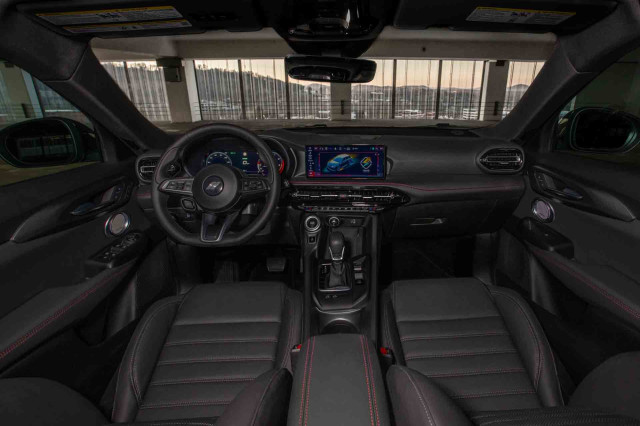
2023 Dodge Hornet GT

2024 Dodge Hornet
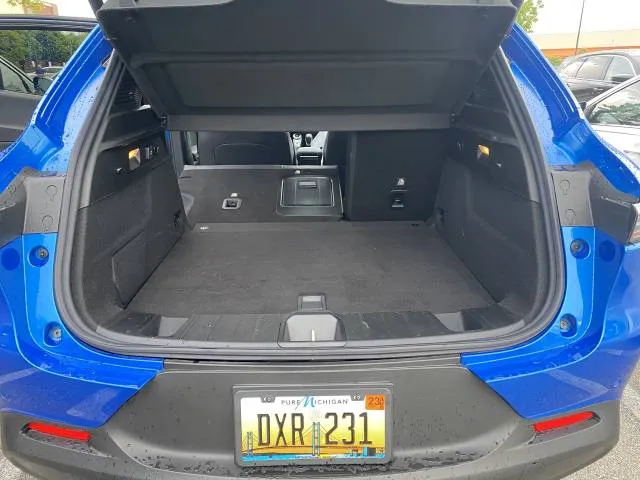
2024 Dodge Hornet
How big is the Dodge Hornet?
Since it rides higher by comparison, it would seem to have more room, but that’s not the case in the Hornet. The cargo specs measure out about the same, at 27.0 cubic feet with the seats up or 54.7 cubic feet with them folded flat, but the cargo hold is narrower with thick side walls. Vertical items benefit, but that’s not the most practical application. The R/T plug-in hybrid trims functional space more due to the battery pack shape and placement, with cargo room cut to 22.9 cubes in back and 50.5 cubic feet with the seats down.
Even though rear legroom is about the same as the Trax at 38.0 inches, it’s harder to get in and out due to narrow lower door openings that require a tuck-and-duck move.
The Hornet’s advantage over the Trax is in its premium fit and finish and slightly taller ride height that many crossover shoppers prefer.
Advantage: The Trax.
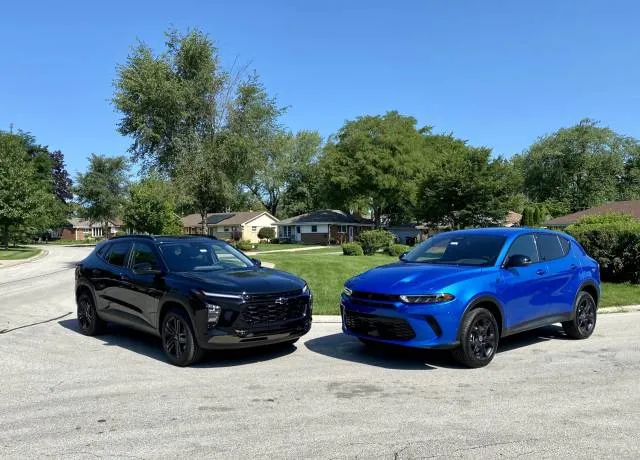
Dodge Hornet (blue) vs. Chevy Trax (black)
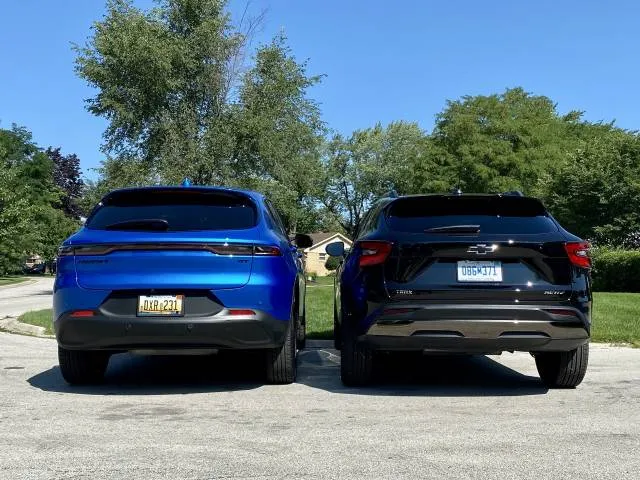
Dodge Hornet (blue) vs. Chevy Trax (black)

Dodge Hornet (blue) vs. Chevy Trax (black)
Chevrolet Trax vs. Dodge Hornet performance
- Trax comes with a 1.2-liter turbo-3 making 137 hp and 162 lb-ft of torque
- It’s front-wheel drive only via a 6-speed automatic transmission
- Hornet GT taps a 2.0-liter turbo-4 making 268 hp and 295 lb-ft; AWD is standard, as is a 9-speed automatic
- Hornet R/T plug-in hybrid churns out 288 hp and 383 lb-ft; AWD is standard via two motors and a 6-speed automatic
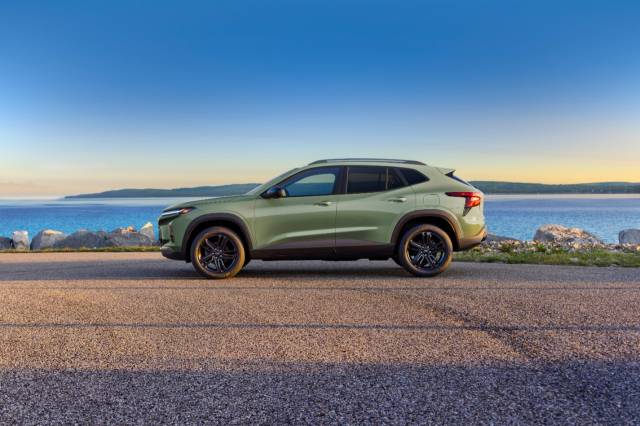
2024 Chevrolet Trax

2024 Chevrolet Trax
How fast is the Chevrolet Trax? Does it have 4WD?
With its 137-hp 1.2-liter turbo-3, the Trax isn’t quick. It’s not slow, either, in part because the 6-speed automatic transmission lets you dig deep into the rev range to access the 162 lb-ft. It’s enough for easy merging into highway traffic, but uphill passes take some daring. It’s possible to override the shifts with a toggle on the shifter, but Chevy limits the manual switching to Low mode only.
The Trax uses front struts and a torsion beam rear axle, so it doesn’t handle as sharply as its profile suggests. But since it’s closer to the ground than other compact crossovers, and not bogged down in weight, there’s some spirit to it.
No Trax offers all-wheel drive; it’s front-wheel drive only.
How fast is the Dodge Hornet? Does it have 4WD?
The two Dodge Hornet powertrains have distinctly different characters. Both the GT and R/T come with standard all-wheel drive, but those systems are different as well.

2024 Dodge Hornet
Dodge Hornet GT performance
The GT’s turbo-4 pairs with a 9-speed automatic that can be slow to respond unless in Sport mode. Dodge quotes a 0-60 mph time of 6.5 seconds and a top speed of 140 mph here. The Hornet needs its inputs to be declarative, as a firm but even foot on the gas lets the power steadily accumulate before a delayed shift. Only mashing the pedal triggers a downshift. In Sport mode, and running higher toward redline, it feels more natural and responsive, and it adds more weight to its electric power steering.
With MacPherson struts up front and a three-link rear suspension, it runs out of town with more verve than the Trax, but its high position results in the Hornet leaning into corners and ramps. Available two-stage adjustable dampers neutralize some of the lean.
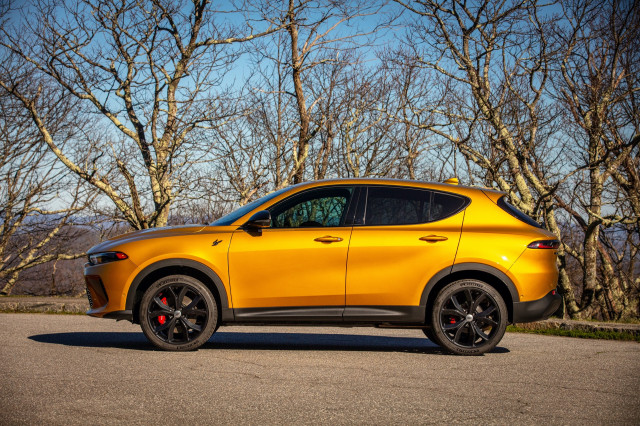
2024 Dodge Hornet R/T
Dodge Hornet R/T plug-in hybrid performance
The Dodge Hornet R/T scoots to 60 mph in 5.6 seconds, thanks to its powerful but complex plug-in hybrid powertrain. A smaller 1.3-liter turbo-4 pairs with two motors, including a 121-hp motor that drives the rear wheels. A 15.5-kwh battery sits below the cargo floor and lines the drive tunnel, and enables an estimated 32 miles of all-electric range. In total, the Hornet R/T drivetrain churns out 288 hp and 383 lb-ft, but various modes activate the power differently, such as EV mode running the rear axle only. In Sport mode a “PowerShot” pull on both paddles can inject an extra 30 hp for 15-second bursts, as long as the battery has at least 80% of charge. The 6-speed automatic has to handle these modes, and its busywork can feel more apparent than in smoother plug-in hybrids.
The R/T rides with 6.1 inches of ground clearance, nearly two inches lower than the GT, and it handles much more like its performance car promise, especially with the available adaptive dampers. Great grip from the tires on the 20-inch wheels combines with that extra weight to plant the Hornet on the pavement and tempt you to push it.
Advantage: Dodge Hornet GT.
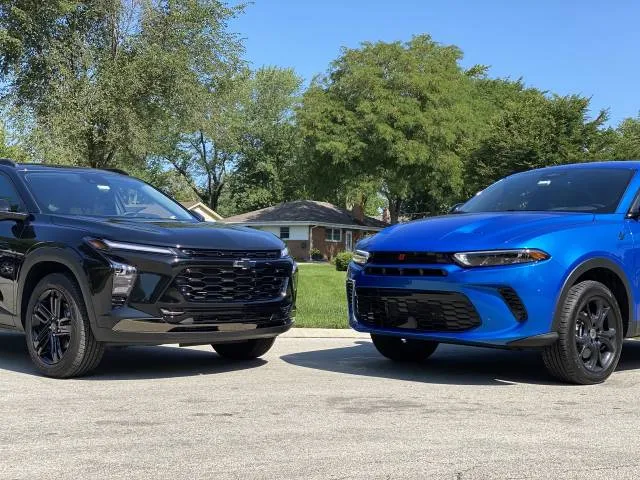
Chevrolet Trax vs. Dodge Hornet fuel economy
- The Trax reaches 30 mpg combined
- The Dodge Hornet GT AWD rates at 24 mpg
- Hornet R/T plug-in hybrid has a 32-mile electric range or 29 mpg combined
Is the Chevrolet Trax good on gas?
With its turbo-3 and front-wheel drive only, the Chevy Trax is very efficient for a compact crossover without a hybrid or plug-in option. It has EPA ratings of 28 mpg city, 32 highway, 30 combined.
Is the Dodge Hornet good on gas?
Both Hornet models come with all-wheel drive that saps some efficiency. The Hornet GT has EPA ratings of 21 mpg city, 29 highway, 24 combined. That’s below average for the class.
The R/T plug-in hybrid makes up for some of that, but the electric boost is more for performance than fuel economy. With its small engine and pair of motors, it can get the equivalent of 77 mpg. On electric power alone, it travels 32 miles, according to Dodge. When the electric juice runs out, it has an estimated rating of 29 mpg combined, which is 1 mpg less than the Trax.
Advantage: Draw. If you log most miles around town in the Hornet R/T, then it can be clean and efficient. Otherwise, the Trax is the better generalist.

Chevy Trax vs. Dodge Hornet safety
- Neither the latest Trax nor the new Dodge Hornet have been tested yet by the IIHS or the NHTSA
- Automatic emergency braking comes standard on both
- The Hornet has more standard driver-assist tech
How safe is the Chevrolet Trax?
The Trax comes with active lane control, automatic high beams, and automatic emergency braking. Rear parking sensors and blind-spot monitors are optional on the base model, and top trims can be fitted with adaptive cruise control.
How safe is the Dodge Hornet?
Dodge equips the Hornet with automatic emergency braking with pedestrian and cyclist detection, active lane control, blind-spot monitors, and rear parking sensors. An available Tech Pack adds adaptive cruise control and a surround-view camera system.
Advantage: Unknown.

Which is better: Chevy Trax or Dodge Hornet?
You can’t beat the value of the 2024 Trax, which helped it earn a TCC Rating of 6.0 out of 10. (Read more about how we rate cars.) It beats the Hornet in looks, too, but the loaded feature set and overall better performance of the Hornet gives it the edge with a TCC Rating of 6.4 out of 10. Still, a $25,000 compact crossover with as much character as the Trax is hard to overlook.
Winner: Dodge Hornet, by some numbers.
https://www.thecarconnection.com/news/1140435_chevrolet-trax-vs-dodge-hornet-compare-compact-crossover-suvs Chevrolet Trax vs. Dodge Hornet: Compare Compact Crossover SUVs





